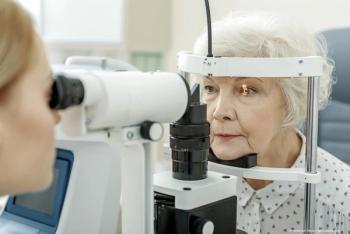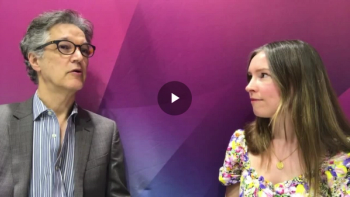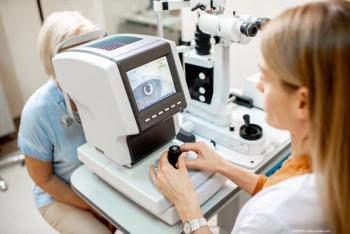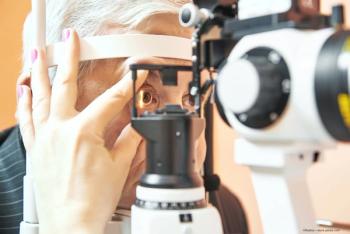
Following the lockdown due to COVID-19, investigators highlight the need to re-assess policies on patient follow-up and establish new approaches to provision of care for elderly patients.

Following the lockdown due to COVID-19, investigators highlight the need to re-assess policies on patient follow-up and establish new approaches to provision of care for elderly patients.

Mr Gokulan Ratnarajan recaps his 2022 ESCRS presentation: "A Real World Comparison Of iStent Combined With Phacoemulsification And Endocyclophotocoagulation (Ice2) With Preserflo And Xen-45 Implants In The UK; Short- And Long-Term Outcomes."

According to Nicox SA, the patients made their final 3-month visit last week. Top line results of the trial are expected in November.

Dr David Lubeck talks with Caroline Richards of Ophthalmology Times Europe about his ESCRS presentations, touching on surgical effects on corneal epithelium and the iTrack Global Registry for glaucoma.

The investigators explained that elevated angle-closure-related intraocular pressure may aggregate the visual impairment in patients with retinitis pigmentosa.

Physicians may need to recognize issues and treat patients more holistically.

Although the standard of care remains the pharmaceutical option, surgeons would like to see other options for individualised treatment, including artificial intelligence and sustained-release technologies.

A team of investigators has found that myopic refractive error is linked with an increased risk of primary open-angle glaucoma, and they indicate that the connection has a genetic foundation.

Genotyping and artificial intelligence are together starting to predict the progression of glaucoma in individual patients, sparing them from suboptimal treatments and side effects. Recent research efforts are exploring modifiable risk factors such as caffeine consumption.

Flavoprotein fluorescence could serve as a new biomarker, according to a Mount Sinai study. This measurement could potentially be used as a first-line indicator to monitor of glaucoma progression for the patient and the physician.

The lower energy applications and slower sweep speeds offer marked IOP reductions in patients.

A team of investigators from the Yong Loo Lin School of Medicine at the National University of Singapore has found that there is a bidirectional association between chronic kidney disease and glaucoma.

Presented at ARVO 2022, research from Mass Eye and Ear hopes to open a new avenue for therapies that are for helping treat patients that develop primary open angle glaucoma.

Each new generation of cyclophotocoagulation options results in more accurate visualisation of the ciliary processes, greater ease of use and fewer complications.

With minimally invasive surgery procedures becoming increasingly popular in glaucoma management, canaloplasty using an ab-interno surgical technique offers enhanced natural aqueous outflow in open-angle glaucoma.

In research sponsored by Skye Bioscience Inc., investigators at the University of Mississippi have demonstrated stronger and longer-lasting reduction of intraocular pressure when a proprietary molecule, SBI-100, is formulated as a nanoemulsion containing the mucoadhesive agent Carbopol 940.

Investigators from the New York University Grossman School of Medicine presented data at the ARVO 2022 annual meeting that concluded mapping of the relative cerebrovascular reactivity in the murine brain showed widespread brain changes resulting from the chronic IOP elevation and demonstrates vascular involvement in glaucoma both within and beyond the primary visual pathways.

An end-of-week review of what happened in ophthalmology from April 9-April 15.

iStar Medical announced the expansion of its commercial rollout of its MIGS implant MINIject® to the UK.

Novel trial design will compare safety and effectiveness outcomes for the OMNI Surgical System and the iStent inject in lowering IOP as a standalone treatment option without concomitant cataract surgery.

A team of investigators at the Okinawa Institute of Science and Technology Graduate University in Japan have identified a gene necessary for the survival of retinal ganglion cells—a class of neurons located in the retina that are critical for vision.

The drug is prescribed as adjunctive therapy for those with glaucoma.

Researchers believe that the prolonged effect of bimatoprost may result from up-regulation of matrix metalloproteinases, leading to sustained remodelling of the outflow pathways.

A team of investigators found that sigma 1 receptor, which is known to protect cells from stress, could turn out to be key to the function and survival of the neurons most impacted by glaucoma.

This new surgical technique offers precision down to the micron level, which is more precise than a surgeon can achieve by themselves.